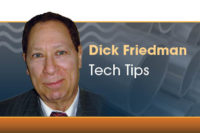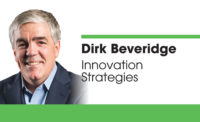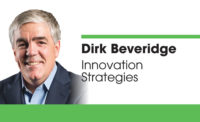Several years ago, I was working with the executive management team at a Fortune 500 distributor designing the sales management processes for the organization.
One of the messages that came down from the executive leadership team was the organization had to drive a new way of thinking where mediocrity was the enemy. They chose to express this new thinking with the words, “Mediocrity in our company is dead.”
They continually talked about how the business could not be sustained through mediocre performance. Mediocrity was seen as a death spiral for the organization, opening the doors to allow competition, both traditional and nontraditional, to steal their business. They believed, and rightly so, mediocrity would kill their organization, and so mediocrity had to go.
It’s an important lesson. If you tolerate mediocrity in your organization, there’s no question you’re going to lose customers to competitors who hold themselves to a higher standard. You have to kill mediocrity before it kills you.
Culture eats strategy for lunch
A few years ago, Thomas Friedman wrote an article for The New York Times entitled, “Average is Over.” The article explained that thanks to advances in globalization and the information technology revolution, today every boss has cheaper, much easier access to a greater amount of above-average software, labor and genius than any other time in history.
Friedman tells us in the article that just doing a job in an average way would no longer return an average lifestyle. In fact, if you think about it, there isn’t a single good job available today that doesn’t require more education than ever before to get it, hold it or advance in it. The same holds true for organizations, which is why we must carefully think through to the answers to two very crucial questions: How do we unleash our organization’s potential, and more importantly, how do we unleash the potential of every individual within our organization?
If we’re going to unleash individual and company performance, we must think culture before strategy.
The Harvard Business Review tells us “Culture trumps strategy every time.” Fast Company magazine tells us “Culture eats strategy for lunch.” This idea also is echoed by Jim Collins in “Built to Last: Successful Habits of Visionary Companies.” In fact, in this groundbreaking book, Collins explains how his research shows organizations driven by purpose and values outperform the general market at a rate of 15-to-1!
Harvard Business School’s John Kotter reached a similar conclusion in his book, “Leading Change,” where his research found that firms with strong adaptive cultures based on shared values significantly outperformed firms with weak, values-neutral cultures. In fact, revenue grew more than four times faster for the firms with strong adaptive cultures. He also found that job creation for these companies was seven times higher and profit performance was significantly higher as well.
Do it in your organization
Culture begins with belief — what you believe in as an organization. We have to think about it, we have to articulate it and we have to communicate it throughout the organization. Start by defining what you believe in as an organization.
That belief, once communicated, then turns into behaviors you’re going to demonstrate yourself as well as ask every employee to follow — from the CEO to the brand-new intern. Decide what the nonnegotiable behaviors are that you’re going to ask of everybody in your organization and communicate them clearly. If someone is going to work for you, they also must believe in your organization’s beliefs, and they must bring the skill and the behavior that will allow those beliefs to live and flourish.
Behaviors then lead to commitment. A commitment, after all, involves holding yourself to your beliefs and behaviors, and at times, being able to step back and say to ourselves “Am I truly committed to the beliefs and behaviors that we as an organization hold to be important?” Then, upon asking, if you and your team can hold firm to those commitments, it’s those commitments that will help drive the results like the ones you see at high-performing distributors.
Unleashing potential requires change
Research we did for our book “Innovate! How Successful Distributors Lead Change in Disruptive Times,” shows 72% of distributors believe the pace of change is too slow in the business. This suggests you’re going to have to change more quickly if you want to unleash potential in your organization to become something you are not today. You’re going to have to help the individuals within your companies grow and develop because they, too, will have to change.
External pressure: There must be enormous external pressure if we’re going to unleash potential and drive change and innovation throughout our organization. In other words, there must be extreme pressure outside the four walls of our business. If you know me, you are certainly aware by now that we live in the age of disruption. You know there are unstoppable forces outside of our businesses that will either propel you and your organization boldly into the future or kill your organization cold.
Both nontraditional and traditional competition is getting tougher. We’re forced to think about and be responsive to alternative channels such as e-commerce. We’re being commoditized in what we provide in terms of pick, packing and shipping. And there’s also been a transfer of power to our customers and end users.
All those forces are classified as external pressures and are therefore out of our control. We can’t change them, so we need to change ourselves by innovating within our own companies to keep up with or stay ahead of these external changes. In this age of disruption, the status quo is the enemy, and there is no room for mediocrity if we’re going to remain viable.
Internal pressure: Internal pressure consists of the people within your business who are strongly dissatisfied with the existing order and status quo. If you’re going to unleash potential, you must find, welcome and respectfully encourage the “troublemakers” in your organization who shake things up in the name of improvement. We must have those who are dissatisfied with the existing order, otherwise without these types of people nothing changes.
When you think about internal pressure, consider the 20-50-30 model. In any given organization, usually around 20% of the people on the team are what I might call the “loyal opposition.” They’re the troublemakers who are going to help you unleash your company’s potential. These are the individuals who are furious with the status quo and know there is a better way. They question the way things are done, they want to change rules and they challenge your normal operating procedures. Much of your company’s future is in their hands as well as yours. They question almost everything, and in doing so, they are actually unleashing company potential.
In the middle are the 50% of your team who I consider the “loyal 50%.” These are the team members waiting to be led and want to become part of the change efforts. They’re interested in having their potential unleashed by learning how to grow, develop and make a bigger impact.
On the other end of this spectrum is the 30% of team members who are not the loyal opposition but rather the “real opposition.” These individuals will fight tooth and nail to protect the status quo. Their mantra is, “We’ve been doing it this way for years, and it’s clearly working because we’re profitable and growing. Why do we want to risk that by changing anything?”
They believe it’s their way or no way. These team members are quick to oppose change of any kind and are staunchly opposed to innovation. These team members will get in the way of your unleashing any potential in your company.
The key to this formula is understanding you’ll have battles between the 20% and 30% who both are going to try to win over the loyal 50% in the middle. The 30% will work very hard to convince that middle 50% to protect and maintain the status quo. Therefore, if we’re going to unleash potential, we need to surround ourselves with more of the 20% group, and create the kind of environment where those employees are supported and can work successfully to win over the 50% in the middle.
Often the 20% are people who see the world differently than we do. The 20% in your organization will, in part, come from a younger generation that understands things such as technology differently and are more savvy about what it can do.
It’s important to remember that because the best ideas come from all levels of the organization — individuals of different tenure and title who notice something that can be done differently — to unleash the potential of your 20% and 50%, you’re going to need to take a different approach and move away from the traditional hierarchy and tap into and harness your company’s internal pressure.
Next time we’ll take a look at the third key to the change and innovation puzzle, the coherent alternative.
This is an excerpt from a new essay from Dirk’s “The Innovation Imperative Essay Series.” Essay details can be found at www.theinnovationimperative.com.





